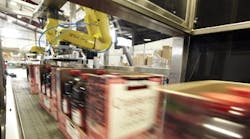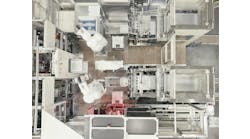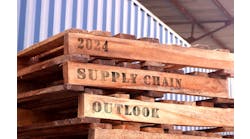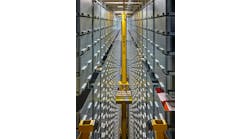By Jim Montague, Executive Editor
If a machine builder wants to remain competitive in a global market, then updating controls, motion, data processing, software and/or networking functions to provide more flexibility, improved speed and reduced costs is a necessity at some point.
PakTech (www.paktech-opi.com) in Eugene, Ore., manufactures handles that bundle two to 12 containers or large single bottles, and builds the machines that apply its handles at high speeds. The company started when founder Jim Borg designed the TwinPak handle in 1992 to accommodate a pair of gallon-sized milk containers. Besides bundling beverage bottles, spray bottles, lawn fertilizer containers and personal care products, PakTech also integrates its systems with those of container manufacturers to add handles to their own products before filling.
These days, PakTech also offers some hard-to-find in-house products and services such as part design and engineering, mold development, injection mold manufacturing, UPC label application, and design, manufacture and servicing of inline application equipment.
PakTech usually starts a new project when a customer requires a new type of multi-pack handle. Its staff first gets a clear idea of the project, develops a 3D image within a week, and then delivers prototype and injection-molded samples within two weeks. This has helped the company stay competitive, adapt to changing requirements, and quickly bring new products to market. However, the company determined that its machines also needed more flexible and affordable controls.
New Capabilities Required
"While developing a new control system, we found that we needed controls that weren't as restrictive and tightly packaged as our previous solution," says Dan Shook, PakTech's operations director. "We also required a user interface that was specific to our equipment, so the look and feel would be the same across different PakTech platforms. Up until this time, we used touch panels from a large PLC manufacturer along with its proprietary software to create pushbutton interfaces, etc. We also wanted to develop a more brand-specific look and feel for our application machinery."
However, the compounding challenge was that PakTech competes against several builders with very low-cost machines that aren't elegant, but they do the job. "Offering a machine with better speed wouldn't win orders—it also had to be affordable. We needed to bring down our controls costs to find a better balance of performance and price," Shook explains. "Competing machines are often stuck at about 25 cases per minute with a lower-quality, die-cut handle. To reach 50 cases per minute, they offer two low-performance machines at $120,000, and run them in parallel, which isn't sustainable if you want to control plant floor utilization and machine footprint. The base PakTech model with our previous PLC-based controls cost $200,000 or more, so we had to expand our control ability, and reduce our costs, which we couldn't do with separate PLC and servo platforms. Layers of components just kept adding up, and we couldn't specify the control system we needed for less than $50,000 with our previous vendor. This was a serious threat to our competitiveness and sustainability. We decided that we had to have something like a PC tying everything together."
PCs + Robots = Flexibility
PakTech began working with Beckhoff Automation (www.beckhoffautomation.com) to redesign its handle application machinery, starting with its MPA60 Multi-Purpose Applicator, which can apply handles at 60 cases per minute. The firm's machines typically integrate with a conveyor and use presence sensors to detect and receive upstream products, control the sequence to a particular location, add handles, check for correct application, move products downstream for further steps, and communicate line speed to other plant systems. MPA60 uses a Fanuc robot arm that picks and places the handles, and its users need only minimal training to program it (Figure 1).
"PakTech aims to make the process as easy as possible for customers by installing the machine at the end user's facility," Shook says. "It cut the required training time in half for our customers by eliminating the time that previously had to be spent in the plant training the maintenance technicians how to navigate through the previous system. Now, the navigation is essentially as simple as pushing a button on the machine. We were initially introduced to Beckhoff's PC-based controls by machinery from Husky Injection Molding Systems (www.husky.ca), which we use to manufacture our plastic handles. This solution is what lets us program code more easily, push information back to the robotic equipment using a standard Ethernet interface, and perform remote maintenance."
By using PC-based controls, PakTech can provide machine information more easily to customers' ERP systems, "which wasn't so convenient in the past," Shook explains. "While it's possible to connect remotely using the traditional PLC, the required software license on the machine means the PLC is all you can see with that license. You don't see the HMI and you don't see the robot interface—those are all connections you must establish with separate licenses."
Controls, Software and Communications
PakTech's MPA60 adopted a Beckhoff embedded PC or industrial PC, as well as control panel, TwinCat software and HMI. To communicate, MPA60 uses EtherCat I/O and terminal box modules mounted outside the cabinets in harsh, IP67-rated environments. The motion system includes EtherCat servo drives, employed as variable-frequency drives, and servo motors. The CX1020 embedded PC was picked because it's a flexible, DIN-rail-mounted controller, and its 1 GHz processor makes it a powerful automation device, Shook adds. It's also small, measuring roughly 6x4.5x4 in. in PakTech's configuration, and it provides a direct backplane connection to the I/O terminals (Figure 2).
"With TwinCat NC PTP software, we're making a bridge to help our customers venture over to structured text (ST)," Shook explains. "We're using TwinCat's ability to work with ladder logic, so we can make code that looks like what some of our customers are used to when necessary. We prefer to use function blocks, ST and programs created in C+ in a way that's in the background from the customer's perspective and is lockable. This goes a long way to protect PakTech's intellectual property and enhances flexibility, too."
For I/O and data exchange on the machine's robots and vision system, PakTech needed Profibus and EtherNet/IP capability. So it implemented Beckhoff's EL6731 terminal that can pass Profibus data over an EtherCat network. To teach the robot and vision system, PakTech also deployed a web browser via EtherNet/IP.
The former PLC-based controls required users to connect with a laptop computer, establish an IP connection, navigate to a main screen with the controller, and so on. "This required too much training and documentation," Shook says. "Today, with our PC-based architecture, we've installed a simple pushbutton on the machine that opens the interface to teach the robot and vision system. It's exceptionally simple by comparison."
Thanks to its upgrades and added capabilities, MPA60 and related PakTech devices have one-touch operation, easy-to-set-up controls and tool-less changeovers. This also eliminated time-consuming and costly efforts to modify and debug PLC code. "Breaking through the old way of designing packaging systems in North America, while we maintain customer trust, is vitally important for us," Shook says.
In addition, machine-mountable EtherCat Box I/O allowed PakTech to accomplish networking and data acquisition in the field to various areas of the machines. "In the past, all our I/O was centralized and we had a lot of wiring back and forth to the field," Shook says. "EtherCat Box I/O eliminated this and the related costs and time required. We also use EtherCat as a drive bus. For us, the two-channel EtherCat servo drive was a surprising fit when used as a VFD. It further consolidated the panel because we now have two motor outputs with every drive. We previously used dedicated VFDs, which were fairly large units that took up a lot of cabinet space."
Similarly, PakTech also needed to implement motion control flexibly without having an automation platform that was overloaded with unnecessary controllers. "For instance, our previous control technology involved a PLC and a separate motion controller communicating via SERCOS," Shook says. "PakTech successfully consolidated these components. With EtherCat and PC-based control, we can implement motion and logic in the same controller. This was a technological leap forward for us, and it helped reduce required electrical panel space."
More Efficiency in Less Space
"Today, we have 20% more control cabinet space to handle additional hardware requests," Shook says. "We also estimate that this change will eliminate an entire eight-hour period from our panel-build phase. Also, we have the ability to scale up to full-servo functionality without buying anything extra, and we're paying about the same as our previous VFD that provided zero servo capability. Using that vendor for a suitable servo system would cost approximately $3,000 more per axis compared with our new system because with the embedded PC and IPC we have the necessary hardware already installed to control servo axes."
As PakTech's control engineers get more accustomed to PC-based control, they're working to introduce it as their standard machine platform. "Some of the things that really aggravated us were the runtime licenses we needed to purchase and renew yearly from our previous PLC vendor," Shook says. "With this solution, we buy the license once and all updates are free, regardless of how old the license is."




